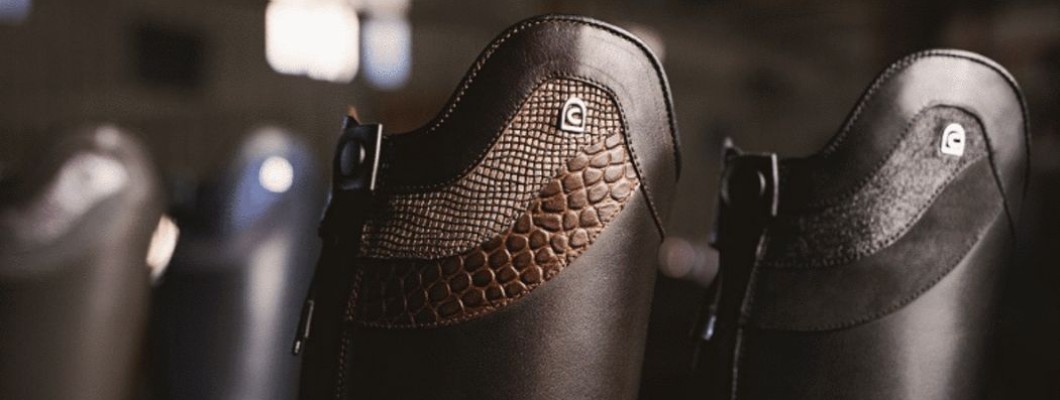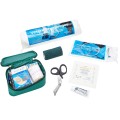
Here are a few things worth knowing about leather boots, jodhpur boots and Hoppiboots…
Leather is a natural material, so the marks on it are not a flaw.
There are a lot of things in the environment that can damage the boots and make them less useful, which is why it's so important to take care of them regularly and correctly.
If you want the boots to keep their original shape, put boot trees in them (don't use metal ones) or fill them with paper when they are not being worn. While being worn, boots take in a lot of moisture from the inside and outside.
It's very important that a riding boot or chap is the right height. If it’s too long, it will get creases and bends, which can damage and scuff the leather.
The zip should be opened all the way to keep it from getting broken. The zip should also be opened and closed with the boot stretched out and without force.
Proper cleaning of boots, jodhpur boots and chaps
Soil, mud, and other types of dirt on the outside of the boots are best cleaned off with warm water and a soft cloth. The boots can then be dried with a soft cotton cloth. Don't use hard brushes or anything like that.
Horse sweat and wet manure are very hard on leather and wear it out. So it's best to wipe it off right away with a damp cloth. If you don't, the leather will stiffen and crack over time, making the boot less durable and less useful.
Zippers need to be cleaned regularly with a small bristle brush. Make sure to get rid of mud and sweat from the horse so the zipper can work well.
After regular cleaning, use zipper spray to give the zipper extra protection.
If your boots or chaps have sticky leather inserts, don't put any kind of care product on them, or the leather will lose its stickiness.
Uppers made of patent leather or carbon-coated leather should be cleaned the same way they always have been, and they don't need any extra care after being cleaned.
Proper drying advice
Depending on how much water they've soaked up, leather boots need at least 24 hours to dry out after being worn.
Boots should not be dried near heat sources or ovens. Instead, they should be dried in a dry, well-ventilated area.
If the leather is dried too quickly or at too high a temperature, it becomes stiff and brittle, which shortens the life of the boot.
If leather riding boots need to be worn every day, we suggest having a second pair to switch to.
How to get the right care
Apply a thin layer of leather care solution evenly over the clean boots and polish them with a woollen cloth or nylon stocking. Please also read the instructions that came with the care solution. Never use products that aren't meant for leather, like shine spray, glass cleaner, hairspray, or anything else like that, as this would immediately damage the structure of the leather.
Good shoe polishes that match or come as close as possible to the colour of the boots are good ways to care for them. Cavallo suggests Kiwi shoe polish, which makes your boots shiny and waterproof.
For extra protection against water, a spray that soaks into the soles can be used (CFC-free if possible, please).


%20(500%20x%20500%20px)%20(500%20x%20500%20px)%20(500%20x%20500%20px)%20(500%20x%20500%20px)%20(500%20x%20500%20px)%20(30)-120x120.jpg)



%20(1)-120x120.jpg)

%20(500%20x%20500%20px)%20(500%20x%20500%20px)%20(500%20x%20500%20px)%20(500%20x%20500%20px)%20(500%20x%20500%20px)%20(69)-120x120.jpg)
%20(500%20x%20500%20px)%20(500%20x%20500%20px)%20(500%20x%20500%20px)%20(500%20x%20500%20px)%20(2)-120x120.jpg)
%20(500%20x%20500%20px)%20(500%20x%20500%20px)%20(500%20x%20500%20px)%20(500%20x%20500%20px)%20(500%20x%20500%20px)%20(63)-120x120.jpg)
%20(500%20x%20500%20px)%20(500%20x%20500%20px)%20(500%20x%20500%20px)%20(500%20x%20500%20px)%20(500%20x%20500%20px)%20(75)-120x120.jpg)
%20(500%20x%20500%20px)%20(500%20x%20500%20px)%20(500%20x%20500%20px)%20(500%20x%20500%20px)%20(7)-120x120.jpg)
%20(500%20x%20500%20px)%20(500%20x%20500%20px)%20(500%20x%20500%20px)%20(500%20x%20500%20px)%20(500%20x%20500%20px)%20(79)-120x120.jpg)
%20(500%20x%20500%20px)%20(500%20x%20500%20px)%20(500%20x%20500%20px)%20(500%20x%20500%20px)%20(500%20x%20500%20px)%20(24)-120x120.jpg)
%20(500%20x%20500%20px)%20(500%20x%20500%20px)%20(500%20x%20500%20px)%20(500%20x%20500%20px)%20(12)-120x120.jpg)
%20(500%20x%20500%20px)%20(500%20x%20500%20px)%20(500%20x%20500%20px)%20(500%20x%20500%20px)%20(10)-120x120.jpg)


%20(500%20x%20500%20px)%20(500%20x%20500%20px)%20(500%20x%20500%20px)%20(500%20x%20500%20px)%20(18)-120x120.jpg)

%20(500%20x%20500%20px)%20(500%20x%20500%20px)%20(500%20x%20500%20px)%20(500%20x%20500%20px)%20(500%20x%20500%20px)%20(20)-120x120.jpg)



Leave a Comment